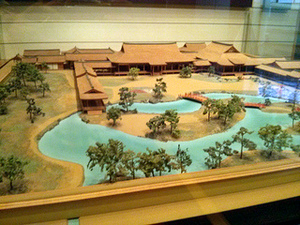Sanjo Palace

The Sanjô Higashi-dono, or Sanjô Eastern Palace, was a major Heian period palace in Kyoto, associated chiefly with the Fujiwara Regents. It covered an area roughly 40 jô square,[1] near what is currently the intersection of Sanjô-Karasuma.
Emperors Ichijô and Emperor Sanjô were born to daughters of Regent Fujiwara no Kaneie at the Sanjô Palace in the late 10th century, and raised there by their grandfather. The palace later passed to Kaneie's son Fujiwara no Michinaga.
In the early 11th century, Fujiwara Iyo no kami Nariie had his mansion here, which was later inherited by his descendant Fujiwara no Iemichi, Chief administrator of the Imperial Household (宮内卿). In 1125, during the reign of Emperor Sutoku, Retired Emperor Shirakawa claimed the site, and built an impressive palace in the shinden-zukuri style. After Shirakawa's death, Retired Emperor Toba took up residence at the palace, along with his empress, Taikenmon'in, until it was destroyed by fire in the 7th month of 1132. The residence, rebuilt, then passed to his son, Emperor Go-Shirakawa.
The palace was famously attacked on 1159/12/9 by Minamoto no Yoshitomo, with a force of over 500 warriors, and set the palace aflame. The Retired Emperor was captured, kidnapped, and confined. And so it was that the Heiji Rebellion broke out.
The Kyoto Central Telephone Office was built on the site in the Meiji period; the building is today home to the Shinpûkan shopping complex.

References
- Gallery labels, National Museum of Japanese History.
- Plaques on-site.
- ↑ Or, two chô from north to south, and one chô from east to west.